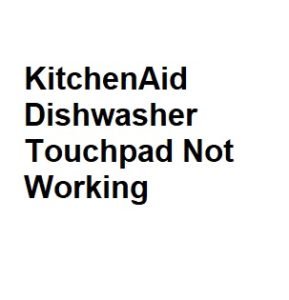A malfunctioning touchpad on your KitchenAid dishwasher can be a frustrating issue, as it hampers the appliance’s usability. However, before rushing to call for professional help or considering a replacement, it’s worth exploring some troubleshooting steps to diagnose and potentially resolve the problem. This guide will walk you through the process of addressing a KitchenAid dishwasher touchpad that is not working.
Step 1: Check for Basic Issues
Start with the basics before delving into more complex solutions:
1.1. Power Supply
- Ensure that your dishwasher is receiving power. Check if it’s plugged in and that the circuit breaker or fuse controlling the dishwasher is not tripped.
1.2. Control Lock
- Verify if the control lock is engaged. This feature can prevent any inputs on the touchpad from registering. Refer to your user manual to learn how to disable the control lock if it’s active.
Step 2: Perform a Soft Reset
Sometimes, a soft reset can resolve temporary glitches:
2.1. Unplug the Dishwasher
- Disconnect the dishwasher from the power source by unplugging it or switching off the circuit breaker for about 5 minutes.
2.2. Reconnect Power
- Reconnect the power and turn the dishwasher back on. Check if the touchpad is responsive. A soft reset can often clear minor issues.
Step 3: Inspect the Touchpad
If the touchpad is still not responding, inspect it for physical damage or debris:
3.1. Clean the Touchpad
- Gently clean the touchpad’s surface using a soft, lint-free cloth. Remove any dirt, grease, or residues that may be obstructing the sensors.
3.2. Check for Physical Damage
- Inspect the touchpad for any visible damage like cracks or water infiltration. If damaged, it may need to be replaced.
Step 4: Test for Error Codes
Your KitchenAid dishwasher might display error codes that can provide clues about the issue:
4.1. Access Diagnostic Mode
- Depending on your model, enter the diagnostic mode by pressing a specific sequence of buttons on the control panel. Refer to your user manual for instructions on accessing the diagnostic mode.
4.2. Note Error Codes
- Once in diagnostic mode, observe any error codes displayed on the control panel. These codes can help pinpoint the problem more accurately.
Step 5: Examine the Control Board
If the touchpad and error codes don’t reveal the issue, it might be related to the control board:
5.1. Disconnect Power
- Ensure the dishwasher is disconnected from power for safety.
5.2. Inspect the Control Board
- Open the dishwasher’s door and locate the control board, typically found on the top of the door or behind the front panel. Check for loose connections, burnt spots, or signs of damage.
5.3. Consult a Technician
- If you notice any issues with the control board, it’s best to contact a qualified technician for repair or replacement.
Step 6: Professional Assistance
If none of the above steps resolve the issue, it’s time to seek professional help:
6.1. Contact KitchenAid Support
- Reach out to KitchenAid customer support or visit their website to find an authorized service technician in your area. Provide them with the details of the problem and any error codes you’ve noted.
6.2. Consider Warranty Coverage
- If your dishwasher is still under warranty, ensure that the repairs are covered to avoid unnecessary expenses.
Common Causes
| Cause | Description |
|---|---|
| Water Damage | Water may have seeped into the touchpad area. |
| Electrical Malfunction | Issues with electrical components can disrupt the touchpad. |
| Sensor Problems | Malfunctioning sensors may affect touchpad response. |
| Software Glitch | Firmware or software issues can cause unresponsiveness. |
| Physical Damage | Physical impact can damage the touchpad or connections. |
Troubleshooting Steps
| Step | Description |
|---|---|
| Check Power Supply | Ensure the dishwasher is getting power. |
| Inspect for Water Damage | Look for signs of water damage near the touchpad. |
| Restart the Dishwasher | Power cycle the dishwasher to reset the system. |
| Clean Touchpad and Buttons | Remove dirt or debris that may hinder operation. |
| Test Sensors and Wiring | Examine sensors and wiring for visible issues. |
Possible Solutions
| Solution | Description |
|---|---|
| Dry the Touchpad | Remove moisture and allow it to dry completely. |
| Replace Electrical Components | Swap out malfunctioning parts if necessary. |
| Calibrate Sensors | Recalibrate or replace sensors as needed. |
| Update Firmware/Software | Install updates to resolve software glitches. |
| Repair/Replace the Touchpad | Fix or replace the touchpad if physically damaged. |
Contact Support
| Support Option | Description |
|---|---|
| Customer Support | Contact KitchenAid’s customer support for assistance. |
| Service Center | Visit a certified service center for professional help. |
| Online Forums | Seek advice from online forums and communities. |
| User Manuals | Refer to the user manual for troubleshooting tips. |
| Warranty Information | Check warranty coverage for potential repairs. |
Prevention Tips
| Prevention Measure | Description |
|---|---|
| Regular Maintenance | Keep your dishwasher clean and well-maintained. |
| Avoid Overloading | Don’t overload the dishwasher to prevent damage. |
| Use Quality Detergent | Quality detergents reduce the likelihood of issues. |
| Soft Water | If possible, use soft water to minimize build-up. |
| Power Surge Protection | Consider surge protectors for electrical stability. |
In conclusion, a non-responsive touchpad on your KitchenAid dishwasher can be frustrating, but with systematic troubleshooting, you can identify and potentially resolve the issue. Remember to prioritize safety, consult your user manual for model-specific instructions, and seek professional assistance if needed to ensure your dishwasher is working smoothly once again.
